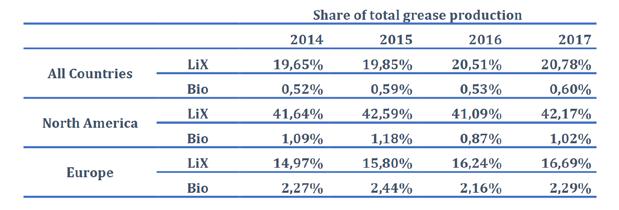
23 minute read
Environmentally acceptable lithium complex grease for a wide temperature range
Roland Ardai Axel Christiernsson International AB Nol, Sweden
Abstract
The year 2019 was a period of change for biodegradable lubricants. The rules and regulations of EU Ecolabel (EEL), US EPA Vessel General Permit (VGP) and Swedish Standard SS 155470 were all revised, resulting in new challenges and opportunities that will impact the environmentally friendly grease business. One example of an opportunity relates to lithium complex thickener technology. Previously, aquatic toxicity and biodegradability requirements were difficult to fulfill with lithium complex-based greases. However, recent regulation changes have now given grease formulators the chance to enter the market with such a thickener.
This paper gives an overview of all the regulation changes implemented in 2019 before going on to discuss the formulation, testing and performance data for an EU Ecolabel-compliant, biodegradable and nontoxic lithium complex grease.
Introduction
What a year! Many of the traditional European green labelling programs and the US EPA Vessel General Permit or VGP underwent revision during 2018. At the beginning of 2019, the EU Ecolabel released a revised regulation to the market. The status of the updated VGP, due at the end of 2018, was still unclear in 2019, and an updated SS 155470 is expected during 2020.
EU Ecolabel
The author had the honour of being involved in the EU Ecolabel revision working group and gained valuable experience as a result. The EU Ecolabel (EEL) was established in 1992 and is recognised globally as a label of environmental excellence awarded to products and services meeting high environmental standards throughout their lifecycle: from raw material selection to production, distribution and disposal. The EEL promotes the circular economy and supports products and services that have a lower environmental impact, contribute to sustainable development throughout their life cycle, are energy efficient and meet a set of high environmental and performance standards. (A circular economy is designed to use recycling and other means to gradually decouple growth from the consumption of finite resources.)
EEL criteria provide useful and straightforward guidelines for companies looking to lower their environmental impact and improve the efficiency of their operational activity through third party controls. Furthermore, many companies turn to EEL criteria for guidance on eco-friendly best practices when developing their product portfolios [1].
Right at the core of the EEL is the lifecycle approach. All of the products that display the EU Ecolabel have been designed to ensure that their main environmental impact is reduced throughout their life cycle. In the case of greases, the life cycle definition is quite limited. It includes selecting the raw materials and whether the product lifetime ends in release to the environment, disposal or, in some cases, with energy regained through waste treatment facilities.
The criteria for lubricant product categories were first established in 2001 by the European Parliament and the Council. Regulation (EC) No 66/2010 states that specific EEL criteria will be established according to product categories. Commission Decision 2011/381/EU established the criteria along with the related assessment and verification requirements for lubricants. That decision was officially in place until the end of December 2018. The EU Ecolabel Fitness check of 30 June 2017 reviewed the regulation and concluded that there was a need to develop a more strategic approach that included streamlined criteria for selecting lubricants.
In order to take into account recent market developments and innovations during the intervening period, it was appropriate to establish a new set of EEL criteria for lubricants. The aim of such criteria would be to promote products that have a limited impact on the aquatic environment, contain a limited amount of hazardous substances and perform as well as or better than conventional lubricants available on the market. In line with the objectives of the European strategy for plastics in a circular economy, the criteria should also seek to facilitate the change by encouraging improved designs and by further incentivising the demand for recycled materials. Commission Decision (EU) 2018/1702 of 8 November 2018 establishing the EEL criteria for lubricants was formally introduced on 1 January 2019.
A transitional period has been given to producers whose products have already been awarded the EEL for lubricants based on the earlier criteria set out in Decision 2011/381/EU, giving them sufficient time to adapt their products to comply with the revised criteria and requirements. For a limited period after adoption of this Decision, producers are also allowed to submit applications based either on the criteria established by Decision 2011/381/EU or on the revised criteria established by this Decision. Where the EEL was awarded based on the criteria established by Decision 2011/381/EU, use of the label should not be permitted after 31 December 2019.
The new criteria, as well as any related assessment and verification requirements, will remain valid until 31 December 2024, considered the innovation cycle for that product group [2].
Vessel General Permit
The Clean Water Act gives authority for the National Pollutant Discharge Elimination System (NPDES) permitting program to regulate the discharge of pollutants into US waters. Since 2008, the EPA has regulated discharges incidental to the normal operation of a commercial (i.e., non-military, nonrecreational) vessel when operating as a means of transportation (i.e., incidental discharges) under the NPDES permitting program. The EPA controlled these incidental discharges primarily through two NPDES general permits: the Vessel General Permit (VGP) and the Small Vessel General Permit (sVGP).
The EPA issued the 2013 VGP with an effective period of 5 years, up to December 18, 2018. The VGP provided nationwide NPDES permit coverage for discharges incidental to the normal operation of commercial vessels greater than 79 feet in length. However, the Vessel Incidental Discharge Act (VIDA) extends the 2013 VGP’s provisions, leaving them in effect until new regulations are finalised and ready for implementation [3].
All vessels must use an environmentally acceptable lubricant (EAL) in all oil-to-sea interfaces, unless technically not feasible. EALs are lubricants that are biodegradable, minimally toxic and not bioaccumulative. For purposes of the VGP, products meeting the permit’s definitions of an EAL include those labelled by the following programs: Blue Angel, European Ecolabel, Nordic Swan, and Swedish
Standards SS 155434 and 155470, Convention for the Protection of the Marine Environment of the North-East Atlantic (OSPAR) requirements and EPA’s Design for the Environment (DfE) [4].
The introduction of VGP requirements had a noticeable effect on the biolubricant market, but uncertainty around the implementation of an updated version slowed down this effect and forced the marine market segment into playing “wait and see”.
SS 155470
In 1998, environmental criteria for lubricating greases were compiled within the Gothenburg project Ren Smörja. These criteria have since been elaborated and are now a part of the Swedish Standard Lubricating Grease – Requirements and Test Methods – SS 155470. After an international hearing, the standard was issued in 2002, with an official English version introduced in 2004. This standard is now widely recognised.
From an international perspective, the environmental requirements are rigorous and signify that the base fluid in the lubricating grease should be biodegradable with minimal aquatic toxicity. Furthermore, an examination of chemical compounds with sensitising properties is also required. A lubricating grease conforming to SS 155470 is classified in one of three environmentally adapted classes, A, B or C, that are differentiated by the maximum level of non-renewable substances allowed. Class A implies the strictest requirements and, with respect to renewable ingredients, Class A stipulates a mass content of more than 65%. The content of renewable resources in Class B should be more than 45%. In contrast, Class C does not include any demands regarding renewable material content [5].
The standard is currently under review, and an updated version is expected in 2020.
Why bio?
First of all, EALs are safer for employees to handle, and secondly, they have less impact on the environment, than traditional lubricants.
End users should dismiss common misconceptions when choosing EALs. In the past, the instability and resulting failures of early EAL technologies created a barrier to future acceptance of newer, higher performing products. Today, operators who use EALs do not need to sacrifice lubricant performance as modern EALs now offer operational benefits that can match, or even exceed, those of top-tier mineral oil lubricants.
When considering the introduction of an EAL, operators must still pay attention to potential issues related to compatibility between the existing and new lubricants as well as equipment components. The incompatibility of ester- and polyalkylene glycol-based lubricants with some widely-used seal materials has historically been a well-documented issue that led to the development of appropriate seals, typically made from fluoropolymers, that are now readily available.
Operators are often unaware that high performing, effective and long-lasting EALs are now available worldwide [6].
Why lithium complex?
Lithium complex (LiX) greases are used widely around the world and particularly popular in North America. Their volume represents over 40% of all grease produced in the US, and worldwide it exceeds 20%. In Europe, the volume is growing quickly, but is not yet as popular as in the US.
While volumes of biobased greases are currently nowhere near such levels in volume terms, according to the 2017 NLGI Grease Production Survey, a growing trend in their production is emerging both in Europe and globally. Legislative controls and changing market trends are increasing the interest in biobased or biodegradable products. It is very difficult to draw conclusions about the North American market at this time [7].
Table 1. Lithium complex (LiX) and biobased (Bio) shares of grease production
Figure 1. Share of lithium complex (LiX) and biobased (Bio) grease production on the basis of 2014 worldwide production
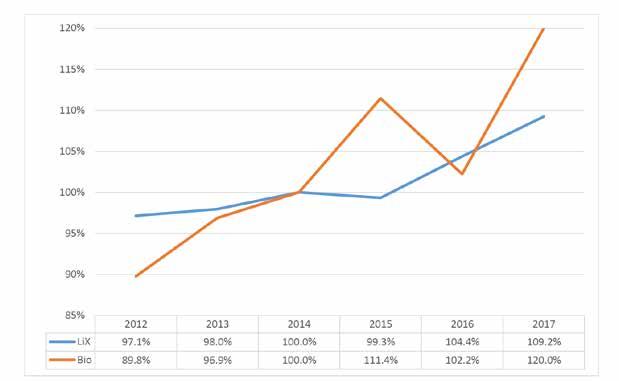
Figure 2. Share of lithium complex (LiX) and biobased (Bio) grease production on the basis of 2014 North America production

Figure 3. Share of LiX and biobased grease production on the basis of 2014 Europe
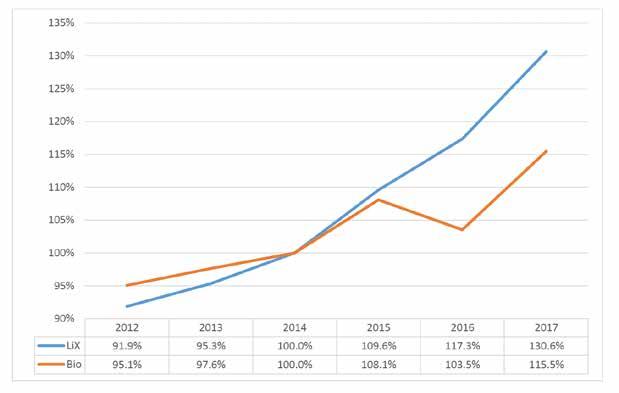
Changes in EU Ecolabel
The key changes for greases are: • New rules for completely excluding or limiting the treat rate of hazardous substances, e.g.
H-phrases, shall now be considered. • Three new subcategories with different aquatic toxicity requirements are based on the risk of release to the environment: total loss (TLL), partial loss (PLL) and accidental loss (ALL) lubricants. • The biodegradability requirements are the same for all three lubricant loss subcategories. • The requirement for renewable content has been removed. But to use the term biolubricant or biobased lubricant, the final product must contain ≥ 25% renewably sourced carbon (EN16807). • Palm oil, palm kernel oil or derivatives must be produced in a sustainable way, and this should be proven with an RSPO (Roundtable on Sustainable Palm Oil) certificate. • Plastic packaging and containers should be made using a minimum of 25% recycled content. • Minimum technical performance must be presented. • Information regarding use and disposal must be present on the packaging.
Changes in VGP and SS 155470
There remain open questions. A new version of VGP was promised (but not released) before the conference where this paper was presented in June 2019. Hopefully, the European green products will be exempt and will be called EAL. The new SS 1555470 is expected in 2020 and will correspond with the European standard of biolubricants (CEN – EN 16807).
Environmental requirements
To understand the limitations of EEL-compliant lithium complex greases, we need to first list the limitations of biodegradability and aquatic toxicity for ALL, PLL and TLL greases.
Table 2. Summary of the environmental requirements for EEL-compliant greases
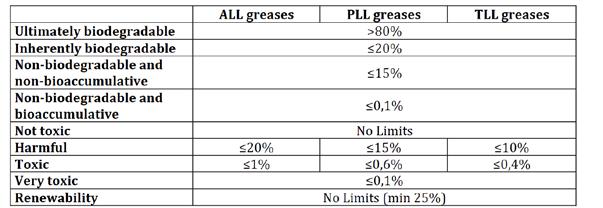
Independent of application type, the readily biodegradable content must be at least 80%, and the nonbiodegradable content must not be more than 15%. Only non-bioaccumulative material is allowed. The differentiation by loss category is determined by the maximum aquatic harmful and toxic material contents. Obviously, the less harmful and toxic the material in the grease, the higher the quantity allowed to be released into the environment. These limitations might make the lithium complex products impossible to use in total loss or even partial loss applications, but the regulation gives the formulators another option with an alternative toxicity evaluation method.
Table 3. Aquatic toxicity requirements for products and main components

With this option, the aquatic toxicity of the lubricant must be tested on three trophic levels, fish, daphnia and algae, whilst those components present at greater than 5% in the lubricant must be tested on 2 trophic levels. If the lubricant itself is not toxic, and the main components meet the given toxicity levels, the product is EEL-compliant according to the aquatic toxicity requirements. In the case of the example presented, it would be beneficial to test aquatic toxicity for proof of compliance with loss categories other than accidental loss, but for this study we worked with calculated toxicity data.
Materials • Soap components
The Lubricant Substance Classification list (LuSC list) provides a good starting point for the selection of raw materials suitable for EEL products. The LuSC is a non-limiting list. Companies are not obliged to use any of these substances or brands. But if they are used, their EEL classifications can be used directly on the application form without requesting the underlying documents [8].

Lithium complex greases are made with lithium 12-hydroxy stearate and a complexing agent, which can vary from dimer acids to boron esters or other chemistries. But for green applications, the options are more limited. The LuSC list gives the toxicity classification and biodegradability of only 3 lithium salts: lithium 12-hydroxystearate (Li12HSA), dilithium azelate (LiA) and dilithium sebacate (LiS). The pure substances are classified below:
Table 4. Biodegradability and aquatic toxicity classification of LuSC-listed lithium soap substances
For the purpose of this paper, the author decided to use sebacic acid because an earlier version of the LuSC list classified LiA as an aquatic toxic material. Today, the classification is the same for LiA and LiS. Previously performed internal studies showed that sebacic acid offered performance benefits in high temperature bearing tests with ester base oils.
To make NLGI grade 2 lithium complex grease presented in this paper, 12 wt.% of Li12HSA and 5 wt.% of LiSA were used. This equates to a total of 17% aquatic harmful content and, therefore, only accidental loss applications are appropriate if component-level aquatic toxicity is considered as the basis for proof of compliance with EEL.
• Base oils
The soap and additives comprise almost all of the non-biodegradable and harmful parts of the grease formulation, so the only possible options for base oils are biodegradable and nontoxic chemistries such as vegetable oils, synthetic esters, polyalphaolefins (PAOs) and glycols. The main purpose of this study is to produce grease with a wide operating temperature range, which excludes the use of vegetable oils on the basis of their relatively high pour points and high unsaturated content. Commercial documents from suppliers show that readily biodegradable PAOs have low viscosities and, therefore, are not best suited for use in multipurpose grease products unless formulations are modified accordingly.
To survive the grease cooking part of the preparation process, where the ester is exposed to high temperature, water, free acid and alkali, the thermal, oxidative and hydrolytic stability of the ester is crucial. However, it is not possible to fulfil all the criteria at the same time with only one ester. For example, the low temperature behaviour, hydrolytic stability and seal compatibility are better for unsaturated esters than saturated ones, but the thermal and oxidative stability of saturated esters are much better than saturated ones [9].
To match the general requirements for multipurpose lithium complex grease and to survive the severe two-step soap forming process, the ester was carefully selected. To ensure high renewable content for this study, an ester was chosen with 320 mm2/s viscosity at 40°C from the LuSC list. This complex ester was readily biodegradable and nontoxic, with limited unsaturated chemistries proven by a midrange iodine value and a low acid value to prevent autocatalytic hydrolysis in the presence of water.
• Additives To provide good lubricity across a wide temperature range and over a prolonged period of time, multiple additives were chosen from the LuSC list that included antioxidants, extreme pressure (EP) and anti wear (AW) additives, a yellow metal passivator and a rust preventive. They are all available on the LuSC list, so environmentally beneficial versions can be picked without compromising technical performance.
Sample preparation
Lithium complex grease samples were made in a laboratory-scale open kettle. The soap was synthesized in around 40% of the total oil volume. The first saponification step, using 12-hydroxystearic acid, was performed with a temperature ramp from around 95°C up to around 110°C. The temperature was then increased to 140°C, which is over the melting point of sebacic acid, where the second soap reaction occurred. The soap was then heated to 208°C before starting the controlled cooling phase using the remaining oils. The grease was finally additised, milled and deaerated for 1 hour.
Methods
In this study, the grease was evaluated using several tests common to the grease industry. These are listed in the table below along with the corresponding standards:
Table 5. Grease tests with corresponding standards.
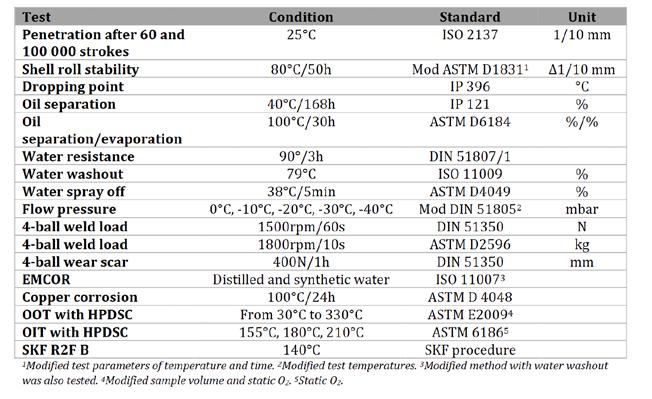
SKF R2F-B test: The continuous upper operating temperatures of the greases were assessed using the SKF R2F-B test. This test consisted of a pair of spherical roller bearings (SKF 22312) that had been run-in according to a specific protocol.
The grease was tested under a constant radial load of 8340 N at a speed of 1500 rpm for a period of 20 days. During the first 24 hours, no external heat was applied. But for the remaining 19 days, the test rig was heated to keep the outer ring at the desired test temperature, which could range from 60 to 160°C.
Following each test run, the bearings and the grease were inspected. The quantity of grease left in the housing was measured, and the lubricant films on the rollers and raceways of the test bearings were inspected. The degree of oxidation, consistency and wear particle content of the grease taken from or adjacent to the bearings were determined. If the conditions in the bearing after the test were judged to be within normal operating conditions, then the test was rated a pass.
Lincoln ventmeter tests: The Lincoln ventmeter determined the pumpability of grease at a given temperature in a 25-foot-long tube and performed at 20, 0, -10, -20, -30 and -40°C. For the low temperature tests, the grease and apparatus were allowed to acclimatise to the test temperature over a period of 4 hours. A pressure of 1800 psi was built up by closing the system. When the valve was opened, the pressure was monitored for a period of 30 seconds by a digital pressure gauge. The test was repeated 3 times, and the average pressure (in psi) was calculated. The specimen was kept in the cold chamber for the entire duration of the test.
Results • General performance
The consistency of grease is given by the concentration, quality and distribution of the soap structure.
The grease in this study had cone penetration values in the range from 265 to 295 (1/10 mm), which represents NLGI grade 2 consistency.
The mechanical stability of grease is the ability of the thickener to withstand shear degradation. In this study, penetration was tested after grease was worked for 100 000 strokes, together with the Shell Roll Stability (SRS) test, which simulated the rolling action inside a bearing. Penetration values before and after mechanical and/or thermal stress were measured, and changes were reported.
The consistency change after 100 000 strokes gave results between 10 and 15 (in units of 1/10 mm). To verify thermal and shear stability, the SRS test was modified by using more severe conditions (from ambient to 80°C, and from 2 to 50 hours). The softening of the grease following this modified SRS test was slightly below 40 (units of 1/10 mm).
Additional standard grease test results are listed below to demonstrate performance of the experimental biobased lithium complex grease (Bio LiX):
Table 6. Test results of the experimental Bio LiX grease
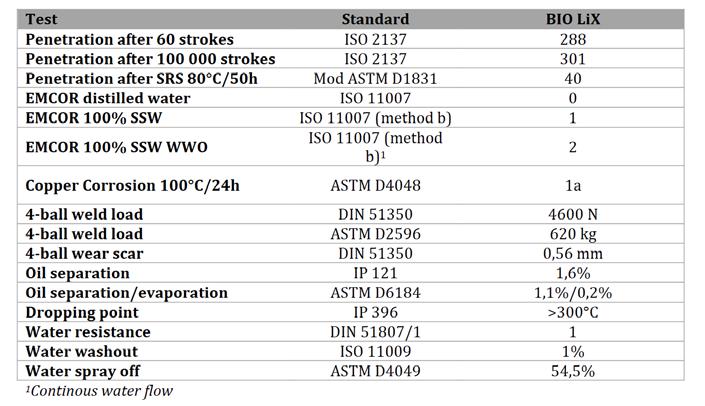
• Low temperature performance
The selected ester has a pour point of -40°C, which also reflected the flow pressure limit for the finished grease, as shown below:
Figure 4. Flow pressure by temperature with logarithmic trendline
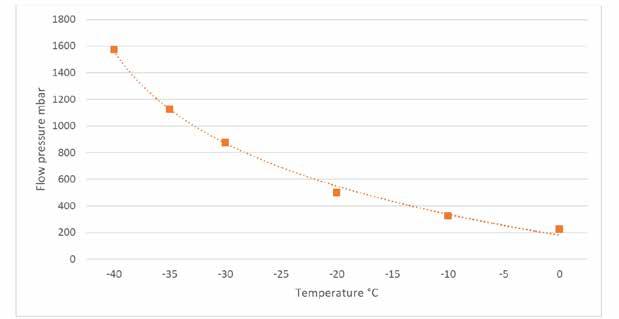
The Lincoln ventmeter method, used to determine low temperature pumpability, is the method that comes closest to simulating central lubricating system application conditions. At room temperature, the Bio LiX sample flowed very easily in the pipe. At -10 and -20°C, resistance to flow progressively increased until -30°C where the grease did not flow at all.
Figure 5. Lincoln ventmeter pressure drop curves for Bio LiX grease

• High temperature performance
The sebacic acid-based lithium complex soap ensured a dropping point above 300°C, but it did not give much information about the thermal and oxidation stability of the grease sample.
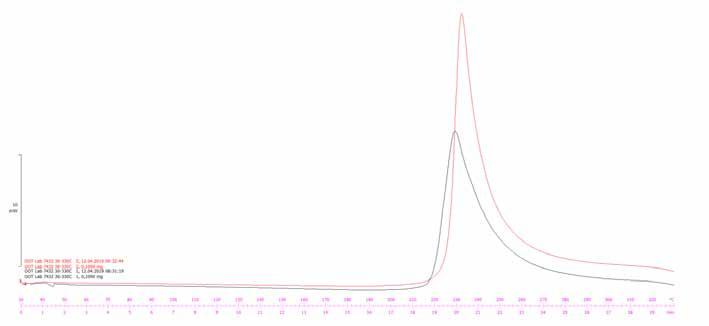
High Pressure Differential Scanning Calorimetry (HPDSC) can give information about the oxidative behaviour of a sample. During the Oxidation Onset Temperature (OOT) test, an oxidation peak was clearly visible around 230°C in repeated scans with the same sample of Bio LiX.
Figure 6. OOT curves of the same BIO LiX sample
Multiple Oxidation Induction Time (OIT) tests were run at different temperatures. At 210°C, oxidation occurred within 5 minutes. The oxidation peak appeared later and less suddenly when the test temperature was reduced to 180°C, and the peak disappeared completely when the temperature was lowered to 155°C:

For bearing applications, the Bio LiX grease was tested in the SKF R2F B test at 140°C, and it passed. At the end of the test, the rollers were covered with a good oil film, and grease consistency changed only slightly. At higher temperatures, the grease was unable to last for the full 19-day test period.
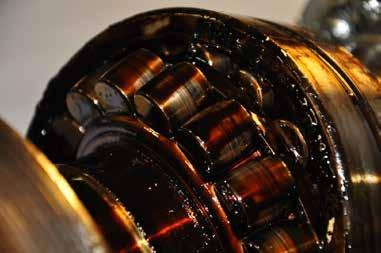
Figure 8. The appearance of the used BIO LiX after 20 days in the SKF R2F test at 140°C
Discussion • Grease properties
The mechanical stability test at room temperature did not result in significant softening of the grease after 100 000 strokes, which demonstrated good structural integrity.
When higher temperatures and prolonged testing periods were applied, the consistency of the sample fell by one NLGI grade. The reasons could be numerous and complex, but this change in consistency was most likely due to a combination of thermal and mechanical degradation of the soap. A 40-unit increase in cone penetration value is considered in line with the normal level of softening expected of synthetic LiX greases.
The storage stability of the sample was considered excellent in light of the oil separation and evaporation results achieved. That said, it is not recommended that this product be kept for decades, because of the fact of its very good biodegradability. Consequently, a typical shelf life of between 2 and 3 years is realistic, if the provided product and packaging are stored appropriately to avoid water ingress or continuous oxygen exposure.
In the copper corrosion test, the sample gave the best possible rating of 1a. Furthermore, corrosion protection in the presence of both distilled water and 100% synthetic sea water, as determined by the EMCOR test, was considered very good despite the limited additive options and low treat rates. In the most severe EMCOR test, where seawater continuously flowed through the test bearing for the duration of the test, the result was still very good.
The 4-ball weld load test, according to both DIN and ASTM standards, showed excellent EP properties for a multipurpose grease product. The AW properties of the sample were also very good at 400 N and 1 hour.
Water resistance in the cases of both the static water and the bearing test was excellent. In the water spray off test, more than 50% of the sample was removed from the steel plate. This was a good result
for a formula that did not include biodegradable polymers to boost such performance. Options for these polymers are available on the LuSC list.
• Low temperature properties Experience with formulated vegetable oil-based lubricants has shown that the pour point alone should not be relied upon as a measure of performance at cold temperatures. This is somewhat unique to vegetable oil-based technology because, although a vegetable oil may have a pour point at a given temperature, that oil may cease flowing at higher temperatures when exposed to cold temperatures for extended periods of time [10]. This behaviour can be improved with the right selection of ester base oil. As mentioned above, higher unsaturated content can help improve the low temperature properties. But in the case of this trial, the grease passed the flow pressure test down to -40°C and was even pumpable in the Lincoln ventmeter down to -20°C, which aligned with the desired wide temperature range of the multipurpose grease requirement. The high quantity of the soap (17%) can be a possible reason why the sample did not show a pressure drop at -30°C.
• High temperature properties A dropping point of >300°C was expected for a high-end synthetic lithium complex grease. The oxidation stability results from the HPDSC tests showed excellent thermal resistance. This was due in part to the low free acid and low unsaturated content of the selected ester, in combination with the antioxidants used from the LuSC list. In the SKF R2F B tests, where the upper temperature limits were determined in a long-term bearing test, the samples passed at 140°C without any problems. The sample discoloured during the 19-day test and started to release oil, as shown in the picture. However, the grease was fit for continuous operation at 140°C based on the results achieved.

• Environmental performance
The grease sample involved in this study met the environmental requirements of the revised EU Ecolabel with respect to accidental loss lubricating greases. Testing the aquatic toxicity of the sample on fish, daphnia and algae could show a positive result and open the possibility of using this grease for partial and total loss applications. This would require that the critical concentration for acute aquatic toxicity on all the tested species is above 1000 mg/l, or the chronic aquatic toxic concentration is more than 100 mg/l.
Table 7. Calculated environmental performance of the Bio LiX grease
Conclusions
This study demonstrated that biodegradable nontoxic lithium complex greases can be formulated to deliver good levels of performance.
The performance profile of the sample involved in this study was purely experimental. The formulation could, of course, be modified to further enhance particular performance features and benefits depending on the specific needs of a wide variety of real world, end-user applications that require an extended operational temperature range.
Acknowledgements
The author would like to acknowledge the support from his colleagues in the R&D laboratory at Axel Christiernsson International for their quick and high-quality testing. The author also acknowledges Dr. Johan Leckner and Mr. Mark Wheeler for technical discussions. This paper was based on a presentation given at the 86th Annual NLGI Meeting, June 8-11th, 2019, at JW Marriott Resort, Las Vegas, Nevada, USA.
References
[1] [Online]. Available: https://ec.europa.eu/environment/ecolabel/products-groups-and-criteria. html [2] [Online]. Available: https://eur-lex.europa.eu/legal-content/EN/TXT/?qid=1542112371100&uri=CELEX:32018D1702 [3] [Online]. Available: https://www.epa.gov/npdes/vessels-vgp [4] [Online]. Available: https://www.regulations.gov/document?D=EPA-HQ-OW-2011-0141-0949 [5] [Online]. Available: https://www.sp.se/en/index/services/lubricanting%20grease/sidor/default. aspx [6] Gavin Lipsith: Four falsehoods and the truth about EALs, Marine Propulsion & Auxiliary Machinery, March 2019 [7] Grease Production Survey Report, NLGI, 2014 and 2017 [8] [Online]. Available: http://ec.europa.eu/environment/ecolabel/documents/LuSClist_06032019_18-1702_no%20track_vs2.pdf [9] Dr. Herman-Josef Stolz, Dr. Martina Mennicken-Meuthen, Dr. Wilhelm Huber Franziska Günther: The iodine value as a measure of the stability of ester base oils, LUBE MAGAZINE NO.150 April 2019 [10] L. Honary and E. Richter, Biobased Lubricants and Greases: Technology and Products, Chichester: John Wiley & Sons, 2011





